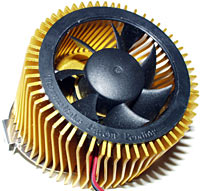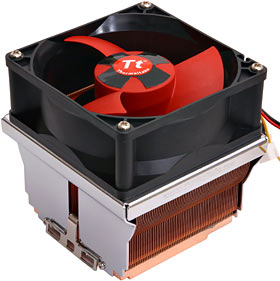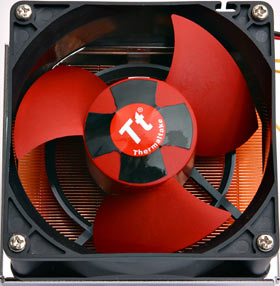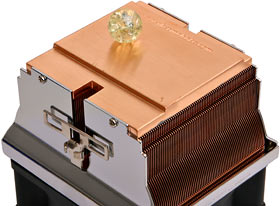
Quick Shot review 11:
Thermaltake Extreme Volcano 12
Review date: 10 December 2003.
Last modified
03-Dec-2011.
Thermaltake used to make funny little round coolers that didn't actually work very well compared with other after-market options. But they looked great and didn't cost much.
Cute as a button, they were.
(Also likely to crush an early Athlon to death, but that's another story.)
When Thermaltake gave up on the "Orb" idea and started making square coolers like everyone else, they suddenly became a real contender in the high performance heat-sink-fan (HSF) market. Especially from the point of view of customers who didn't see much reason to spend twice as much money on some super-exotic mail-order ultra-cooler to get 5% better performance, when the whole Thermaltake range was available cheap at umpteen ordinary computer stores.
Recently, Thermaltake have been muscling into the giant weighty thin-fin copper cooler market, and their flagship product as I write this is...
...this.
The Extreme Volcano 12 is an 80mm-fan cooler with a super-thin-fin all-copper heat sink, surrounded by a sturdy steel fan-mount frame. Here in Australia, it sells for around $AU60
The whole Volcano 12 weighs an inspiring 725-odd grams, and it attaches to your hapless Socket A with a plain vanilla single-piece three-hole steel retainer. There's not even a thumb-rest; you need to use a good old flathead screwdriver to clip the thing on.
Because this cooler's about 2.4 times as heavy as anything AMD recommend you hang off a CPU socket, you should be very, very careful about transporting a computer with a Volcano 12 installed in it.
It's heavy, and it's tall; the Volcano 12 stands almost 90mm high, thanks in no small part to...
...that rather distinctive fan. With no finger guard. Take care.
(Oh, and the sticker's cheesy, but it peels off.)
The fan is 32mm high, and its three blades take up most of that thickness; the motor assembly's not supported by any more plastic than you'll find in a normal 25mm thick fan. There's a single air-guiding "specific ring" (to use Thermaltake's peculiar words) half way in from the edge of the fan, but nothing like the hefty ductwork you'll find in some very tall fans.
This fan is alleged to move almost 73 cubic feet of air per minute at full speed, though it won't shift anything like that much through the resistance of the Volcano 12 heat sink.
Cooling fan aerodynamics can get complicated. Swept area, blade profile, static pressure, free-air flow, RPM limits for acceptable noise levels; a lot can go into the design of a modern pentametric fan.
The way the equations shake out for most 80 and 92mm computer cooling fans, though, means they have seven blades. Generally speaking, fewer blades mean higher efficiency; the same goes for propellers, which is what gave rise to the counter-weighted single bladed props used by some very strange aircraft. But it's my no doubt criminally over-simplified understanding that dropping a normal cooling fan design to, say, three blades, would mean you'd have to run the blades so fast to get the same air flow as a less efficient 7-blade fan that the resultant device, while efficient, would make too much noise and/or wear out too fast.
Well, what do I know? Thermaltake have made this rather butch looking three-bladed fan, with plenty of space between the blades, and the blighter seems to work just fine. It ain't quiet at full speed, but it's only got about 4.8 watt run power and isn't any louder than I'd expect for that power level. It's a long way from qualifying as a silent computing solution, but at its top speed of 5500RPM it's way quieter than the ridiculous finger-removing Delta Focused Flow monsters with twice or three times the power rating.
You still shouldn't run this fan from a motherboard header, though, so Thermaltake don't give you the option; there's a passthrough four-pin power connector on the end of a generous two foot wire, and a separate single-wire tachometer lead that you can connect to a fan header for speed monitoring.
If you want to run the fan at less than full speed - and you probably will - the Extreme Volcano 12 package gives you three options.
Not one but two simple potentiometer speed knobs, one for a rear panel expansion slot and one for a 3.5 inch drive bay. The drive bay controller has mounting points for three more pots, which may be of interest to modders; you'd have to use smaller knobs for them than the almost-an-inch-wide one that's already installed, though.
Both potentiometers feel smooth and expensive, but they're not automatic speed controls. For that, you can use...
...a standard super-thin thermal probe, on the end of a short cable that ought to still be adequate for sticking the probe anywhere on the heat sink you like. The probe only needs 55°C to get the fan to run at full speed, so you don't need to stick it right next to the processor contact patch to have full power on tap.
As with previous speed-controllable Thermaltake fans, this one runs at full speed all the time if there's no controller plugged in.
The base of the Volcano 12's flat and smooth, and features an engraved Thermaltake URL, just because. The engraving's deep enough that you'll still be able to read it if you lap the base, but I really don't think that's necessary.
Testing
So - does the Volcano 12 work?
Yes, it does. Very well indeed. At full power, the Volcano 12 scored a very imposing 0.44°C/W, mixing it up with the best air coolers I've seen . Not bad for something you can buy any old where.
At minimum power, the V12's fan turns at a lazy 2000RPM, which with its three blades means it's likely to be quiet enough for anybody. This cuts its performance back to an unexciting 0.64°C/W - but that's still better than Thermaltake's old, noisy, twin-fan Super Orb managed.
Wind up the V12 fan until it makes a normal about-the-same-as-the-PSU-fan racket, and it should perform well enough to keep pretty much any Socket A processor cool. Well, provided you've got passable case ventilation and the ambient temperature isn't melting your monitor casing, anyway.
At 5500RPM, the V12's a world class performer, and not nearly as deafening as many top-flight solid-metal coolers. It's not nearly as effective on a noise-versus-cooling basis as the new breed of heat pipe coolers (see this review for a great example), but for a mass market product, it's remarkable.
The only oddity I encountered while testing the V12 was that after more than half an hour of minimum speed running with the drive-bay speed controller knob connected, the fan started revving up and down noticeably. I'm not sure why this was; a bit of potentiometer abuse with a butane torch indicated that it wasn't heat related, and the pot seemed fine on a multimeter. The other speed control pot didn't have this problem.
I've only checked out one Extreme Volcano 12, though, and I haven't heard of anyone else with this problem. I think it'd only be likely to bother people using a V12 in a "silent" PC.
Overall
The Extreme Volcano 12 is an excellent package for the price. It's a big fat cooler that's not suitable for a computer you intend to move, and most people can make do with something cheaper, but there's not much else to dislike about it.
Recommended.
Thermaltake's page for the Extreme Volcano 12
Buy one!
Aus PC Market doesn't sell
this cooler any more.
Click
here to see their current fan-related products!







